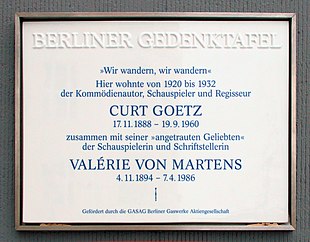Berlin memorial plaque
The Berlin porcelain memorial plaque from the Königliche Porzellan-Manufaktur (KPM) is a special form of memorial plaques in Berlin , which was introduced in 1985 in preparation for the city's 750th anniversary in 1987.
The porcelain-colored plates have a format of 40 cm x 60 cm and bear with sublime writing the title "Berlin Memorial Plaque" in capital letters and a cobalt blue explanatory inscription. Finally, the KPM company logo , a cobalt blue scepter , is shown. The design was determined in a competition that graphic designer Wieland Schütz won with his design.
prehistory
As early as the 19th century, the Berlin magistrate began to set up memorial plaques and memorials for people and events in all public spaces . For the year 1930, for example, the list includes 59 memorial plaques in the inner district alone, a further 47 copies in all other districts are precisely specified (person / event, location, material, date of installation / installation). In the 20th century, uniform representations were sought and the Berlin memorial plaque was developed.
aims
For the installation of a Berlin memorial plaque, the guidelines for the memorial plaque program apply:
“The only criterion for those to be honored is the performance for or in Berlin. Political beliefs or alibi functions are not taken into account. In principle, only people or institutions should be given a memorial plaque that is also of supraregional importance. In addition to personalities, the memorial plaque program also takes into account the memory or commemoration of historical sites, institutions, squares and buildings. "
chronology
1985-1991
Originally, the design and manufacture of a board cost around 1200 marks . According to the plans at the time, each district of West Berlin was to receive around 25 commemorative plaques of this kind - sponsored by the Berliner Sparkasse .
The first three memorial plaques were put up on October 22, 1985.
1992-2000
After the political change , the memorial plaque program was also extended to the eastern districts of Berlin , for which the Sparkasse made another amount available. A total of 350 bars, now worth 3,000 marks per board, were planned by the year 2000. The Historical Commission to Berlin e. V. took over the technical support of the project.
Even after 2000, memorial plaques from this program were still attached, for example for Rudolf Breitscheid , as the plaques were already prefabricated and only the specific lettering had to be attached .
Since 2000
Now an applicant has to submit a cost assumption declaration for around 2500 euros, the owner of the installation site must have his written consent for the installation and the district council of the corresponding district must have given its positive vote. The Historical Commission zu Berlin e. V. in agreement with the applicant the text for the memorial plaque. Wieland Schütz then takes care of the graphic implementation of the text, sometimes with additional design features. The final printing on the board is done by KPM. Finally, the applicant takes care of the affixing of the board, which becomes the property of the respective district office .
Memorial plaques
Examples of some Berlin memorial plaques. Further images can be found at → Wikimedia Commons .
Berlin memorial plaque for Shepard Stone
Berlin memorial plaque for Rudolf Mosse at the Mosse-Stift
Berlin memorial plaque on the Bonhoefferhaus
error
Some of the panels have inconsistencies. The honor for Johann Ernst Gotzkowsky in the Brüderstraße in the Mitte district contains two mistakes: a wrong year of birth and a wrong year for the Russian occupation of Berlin .
See also
literature
- Constanze Döhrer, Volker Hobrack, Angelika Keune (eds.): Traces of history. New memorial plaques in the center of Berlin. Berlin Story Verlag, Berlin 2012, ISBN 978-3-929829-44-0 .
- Rosemarie Baudisch, Wolfgang Ribbe : Commemoration on porcelain. A city remembers. Joint publication of the Historical Commission in Berlin and the Berlin State Archives . Nicolaische Verlagsbuchhandlung, Berlin 2014, ISBN 978-3-89479-843-7 (Berlin memorial plaques).
Web links
Individual evidence
- ^ "Berlin memorial plaque program". Memories in porcelain. In: Der Tagesspiegel . June 6, 2007, accessed July 22, 2017.
- ↑ Memorial plaques and memorials . In: Berliner Adreßbuch , 1930, Appendix, p. 221 f.
- ↑ Elmar Schütze: Forum wants to put up signs on several houses in the Havelstadt / Further suggestions requested: memorials commemorating Jewish history. In: Berliner Zeitung . February 15, 1997. Retrieved July 22, 2017.
- ^ Holger Huebner: The memory of the city. Memorial plaques in Berlin (preface to the 1997 edition) (PDF; 133 kB). In: gedenkenafeln-in-berlin.de, May 13, 2012, accessed on July 22, 2017.
- ↑ Katharina Körting: Glienicker Brücke: CDU enforces its memorial plaque: No word about the exchange of agents. In: Berliner Zeitung . April 12, 2000. Retrieved July 22, 2017.
- ↑ Speech by District Mayor Monika Thiemen on August 24, 2002. On the unveiling of a commemorative plaque for Rudolf Breitscheid on the 58th anniversary of his death at his former home at Fasanenstrasse. 58, 10719 Berlin. In: berlin.de, accessed on July 22, 2017.
- ↑ Verbatim minutes of the Committee for Cultural Affairs of May 30, 2005 (PDF; 175 kB). In: parlament-berlin.de, accessed on July 22, 2017.



